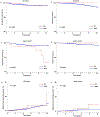Recurrence, death, and secondary malignancy after ovarian conservation for young women with early-stage low-grade endometrial cancer
- PMID: 31427143
- PMCID: PMC7537353
- DOI: 10.1016/j.ygyno.2019.08.007
Recurrence, death, and secondary malignancy after ovarian conservation for young women with early-stage low-grade endometrial cancer
Abstract
Objective: To examine the association between ovarian conservation and oncologic outcome in surgically-treated young women with early-stage, low-grade endometrial cancer.
Methods: This multicenter retrospective study examined women aged <50 with stage I grade 1-2 endometrioid endometrial cancer who underwent primary surgery with hysterectomy from 2000 to 2014 (US cohort n = 1196, and Japan cohort n = 495). Recurrence patterns, survival, and the presence of a metachronous secondary malignancy were assessed based on ovarian conservation versus oophorectomy.
Results: During the study period, the ovarian conservation rate significantly increased in the US cohort from 5.4% to 16.4% (P = 0.020) whereas the rate was unchanged in the Japan cohort (6.3-8.7%, P = 0.787). In the US cohort, ovarian conservation was not associated with disease-free survival (hazard ratio [HR] 0.829, 95% confidence interval [CI] 0.188-3.663, P = 0.805), overall survival (HR not estimated, P = 0.981), or metachronous secondary malignancy (HR 1.787, 95% CI 0.603-5.295, P = 0.295). In the Japan cohort, ovarian conservation was associated with decreased disease-free survival (HR 5.214, 95% CI 1.557-17.464, P = 0.007) and an increased risk of a metachronous secondary malignancy, particularly ovarian cancer (HR 7.119, 95% CI 1.349-37.554, P = 0.021), but was not associated with overall survival (HR not estimated, P = 0.987). Ovarian recurrence or metachronous secondary ovarian cancer occurred after a median time of 5.9 years, and all cases were salvaged.
Conclusion: Our study suggests that adoption of ovarian conservation in young women with early-stage low-grade endometrial cancer varies by population. Ovarian conservation for young women with early-stage, low-grade endometrial cancer may be potentially associated with increased risks of ovarian recurrence or metachronous secondary ovarian cancer in certain populations; nevertheless, ovarian conservation did not negatively impact overall survival.
Keywords: Endometrial cancer; Ovarian conservation; Recurrence; Secondary primary cancer; Survival.
Copyright © 2019. Published by Elsevier Inc.
Conflict of interest statement
Declaration of competing interest
Research grant, Pfizer, Yakult Honsha, OncoThreapy Science, honoraria, Chugai, Daiichi-Sankyo, Ono Pharmaceutical, Eisai, Kyowa Hakko Kirin, and Bayer Yakuhin, advisory board, Merck Sharp and Dohme (K.H.); honorariums, Chugai and Astra Zeneca (T.E.); consultant, Tesaro and Clovis Oncology, research funding, Merck (J.D.W.); honorarium, Chugai, textbook editorial, Springer, and investigator meeting attendance expense, VBL therapeutics (K.M.); consultant, Quantgene (L.D.R.); research grant, Merck and Tesaro, advisory board/consultant, Tesaro, Stryker, Astra Zeneca, Celsion, Abbvie, Iovance, Clovis, Genentech, and speaker bureau, Astra Zeneca, Tesaro, and Merck (P.H.T.).
Figures



Comment in
-
Hormone therapy in endometrial cancer survivors: time for a change.Gynecol Endocrinol. 2022 Oct;38(10):795-796. doi: 10.1080/09513590.2022.2128105. Epub 2022 Sep 28. Gynecol Endocrinol. 2022. PMID: 36170886 No abstract available.
References
-
- Torre LA, Islami F, Siegel RL, Ward EM, Jemal A, Global cancer in women: burden and trends, Cancer Epidemiol. Biomark. Prev 26 (2017) 444–457.Torre LA, Islami F, Siegel RL, Ward EM, Jemal A. Global Cancer in Women: Burden and Trends. Cancer Epidemiol Biomarkers Prev 2017;26:444-457. - PubMed
-
- Cancer Stat Facts: Uterine Cancer. National Cancer Institute Surveillance, Epidemiology, and End Results Program. <https://seer.cancer.gov/statfacts/html/corp.html> (accessed 4/17/2019).
-
- Morice P, Leary A, Creutzberg C, Abu-Rustum N, Darai E, Endometrial cancer, Lancet 387 (2015) 1094–1108.Morice P, Leary A, Creutzberg C, Abu-Rustum N, Darai E. Endometrial cancer. Lancet 2015;387:1094-1108. - PubMed
-
- Uterine Neoplasms. NCCN Clinical Practice Guidelines in Oncology. National Comprehensive Cancer Network. <https://www.nccn.org/professionals/physician_gls/> (accessed 4/17/2019).
-
- Wright JD, Take 'em or leave 'em: management of the ovaries in young women with endometrial cancer, Gynecol. Oncol 131 (2013) 287–288.Wright JD. Take 'em or leave 'em: management of the ovaries in young women with endometrial cancer. Gynecol Oncol 2013;131:287-8. - PubMed
Publication types
MeSH terms
Grants and funding
LinkOut - more resources
Full Text Sources

